|
After 5 years frustration trying to get one
of my old 1970’s era F2B motors running properly, success
was finally achieved by doing my own piston/cylinder/ring
fits. My Eather-built Firecracker test ship is now a mere
pale shadow of its former glory, the result of many engine/tank
changes, plus hitting a tree branch. After repairs, it weighed
2 kg, so a new model was long overdue. My Enya 45 6001 with
Supercool 11X7 has about 1.2 kg static thrust, so its expecting
a bit much for the old Enya to drag the 2 kg model through
safe reverse wing-overs in the wind.
My thoughts returned to the old 1973 Anna Domini
design, long a cherished favourite, and well remembered by
my associates of that era. While it is a truly magic design
(plan still available from Supercool!), the building time,
like most F2B models, is at least 2 months. Also, wood selection
to keep the weight down is very time and cash consuming. Both
remaining life and cash are quantities of which I am running
low. So how to build a light, competitive model in a short
time became my principal concern.
The Dominator/G15 combat model of 1965 has
always been a favourite of mine. Easy to build straight, cheap,
quick to build and rugged, just a bit too small for F2B and
no wheels or muffler. But if you are quick on the handle,
it will do nice squares, in fact, the whole pattern with no
problem at all: so how about a big version, with wheels, to
take a 45?
I am further influenced by Bob Fry’s
Open Combat model “Laminator”, also a flying wing.
With an OS40 FSR it flies in excess of 100 MPH, turning so
tightly on such a small amount of elevator movement that I
found it hard to believe. If by marrying Bob’s ideas
on aerodynamics with the ease of construction of a Dominator,
then I was going to be at least half way there.
I didn’t want Bob to get all the credit,
so I made some superficial planform changes to end up with
the beast in the photo. The undercarriage was mounted on 2.5mm
ply plates, which were glued straight onto the massive Dominator
style leading edge, solving that problem quite elegantly (says
I). With no fuselage, flaps or tailplane to build, the weight,
covered in very heavy Vilene, came in at the desired 1.23
Kg, without effort made in saving weight anywhere! This was
promising!
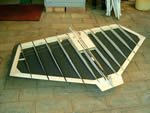
Having no real idea where the C/G should be,
I drilled extra engine mounting-boltholes, to give the option
of placing the C/G well forward. With real terror at the prospect
of an unstable rearward C/G for the first flight, the engine
was put fully forward, plus a big bar of brass was mounted
behind the engine on the spare rearward boltholes. Well, that
sure worked out OK, the model could barely loop! In the event,
I was able to remove the brass bar, the place the engine fully
back: this got the C/G close (no ballast, how is that for
blind luck?), but wasn’t the end of the problems.
With full down elevator, I managed to do a
46 degree bunt from 45 degrees: the grazing descent into terrain
at full speed ripped a wheel leg out by sheer inertia, breaking
off the ST needle at the spray-bar. More business for Bill
Swan! After the minor repairs, a rethink was needed. This
was embarrassing.
Even raw beginners were coming up to me, saying
“hey, old guy, your elevator is too small”. When
my beard was long, a 4 year-old rode up to me on his trike
and asked me if I was God, which seemed to me a reasonable
thing to ask. But 16 year olds telling me that the elevator
was wrong is a bit depressing. So I slunk off, having admitted
nothing, then put on a much bigger elevator. As much as I
hate to admit it, they were right: the ship started to do
nice square manoeuvres, with prospect of F2B performance within
reach.
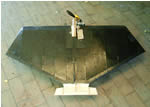
At this point, it was time for a public appearance
of the model, so it was off to the 30 year celebration of
the formation of TARMAC club by Jim Stivey, Fred Tower and
the boss, Lorraine, held at Lumen Christi College in Gosnells.
No sooner had I plonked it on the ground, than up walked Norm
Kirton, who announced to all and sundry, “you gotta
call that the BAT”. Gee Norm, I thought “Heart
of Gold” or “Light of the World” or even
“The Infidel”, but surely not “The Bat”!
My mind flashed back to the 50’s. My
school chum and good mate Harry Cooper, now TV-star vet, had
built a flying wing model from Model Airplane News called
the “Bomb Bat”. This flew quite well, but was
not really a stunter. The only other flying wing stunters
I could think of were Charles Mackey’s “Red Wing”
and Wild Bill’s “Fierce Arrow”. Harry’s
dad had brought back from Japan an Enya 60, one of the first,
with the 5 (or was it 6?) bolt crankshaft retention. Wonder
if he has still got it?
I remember flying the Bomb Bat quite well,
as Harry had a rowing boat and we needed to row across the
Lane Cove river to get to the flying field. Being a weak swimmer,
this worried me a bit, but it was fun dragging the wingtip
of my scaled up OS29 Max II powered Aeromodeller design “Pedro”
in the water, while watching the wake.
At this point it was time to do some serious
trimming. First off, the model was rolling too much in squares.
As the tip weight was only held on with sticky tape, the one
ounce of lead was easily removed and moved inboard. Well,
when I say inboard, it really is; I now have _ ounce lead
halfway along the INBOARD wing!
Things were looking pretty good, the one problem
remaining being that the engine was going rich on outsides:
risky. So I changed the motor to my Enya 45 6002. This is
a new policy of mine. Anything goes wrong, then change the
motor.
Well it didn’t work this time, so I cut
out the tank and remounted it in a box, held down with rubber
bands. Tank level could now be adjusted with shims under the
tank. The tank also was an experiment. By keeping the uniflow
vent to the front, it was hoped to emulate Peter Smith’s
beautiful 4-2 break, but that didn’t work either. Having
previously had problems at the end of the run, the tank was
angled out at the rear, while the uniflow vent went into a
bubble on the side of the tank. There is nothing worse than
aborting the clover due to engine cutting in the first loop,
then having the engine re-catch and run for another 10 laps.
Been there, done that.
In the event, it was necessary to raise the
tank 6mm, which was a bit weird. Still, it worked, so if you
go this route it might be best to make your tank movable as
well.
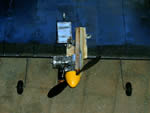
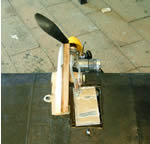
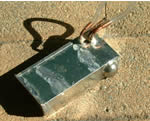
To conclude, here are the vital specs:
Span: 47”
Wing area: 650 sq. in
Weight: 1.23 kg (43 ozs)
Root chord: 22”
Tip chord: 14”
Ribs: 4mm balsa, carbon capped
Spar: none
C/G: 20% of root chord
Line rake: 1” behind C/G
Elevator span” 13”
Elevator chord 2.5”
Section: Dominator
Covering: Vilene (.0055”, heavyweight)
Engines: Enya 45 6001/6002 (ring motors,
crossflow, mid 70’s)
Muffler: Supercool F2B, side mount, 2 chamber
Prop: Supercool petal-type 11 X 8.5
Line length: 65’
Lap time: 4.8 – 5.2 seconds
Tank: 100cc, Palmer uniflow type: uniflow
vent in bubble

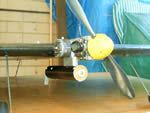
By the way, if you have any of Enya 45 6001,
6002 or Enya 35 II in surplus, then I would like to make you
an offer for them. Till next time, stay Supercool. |